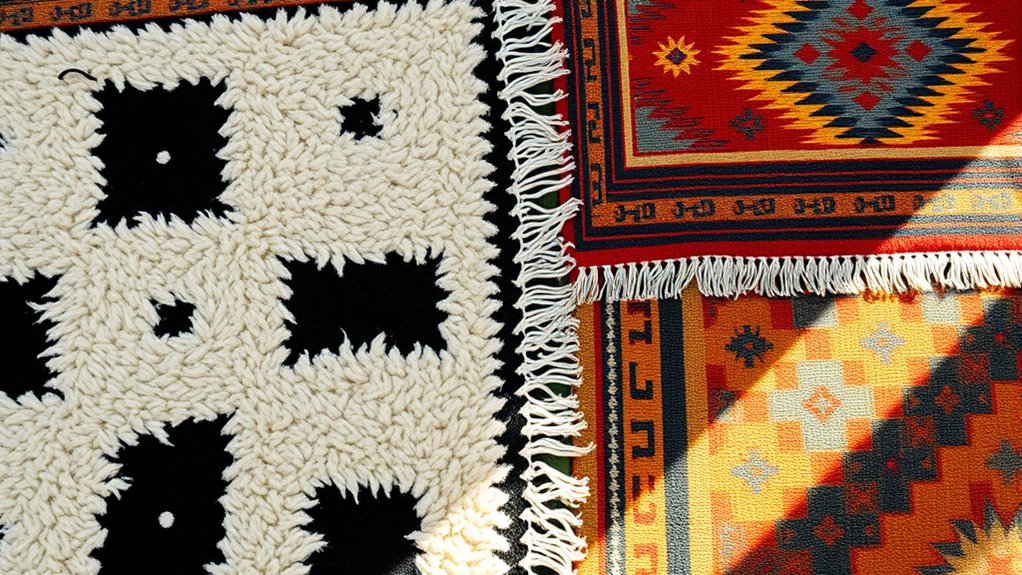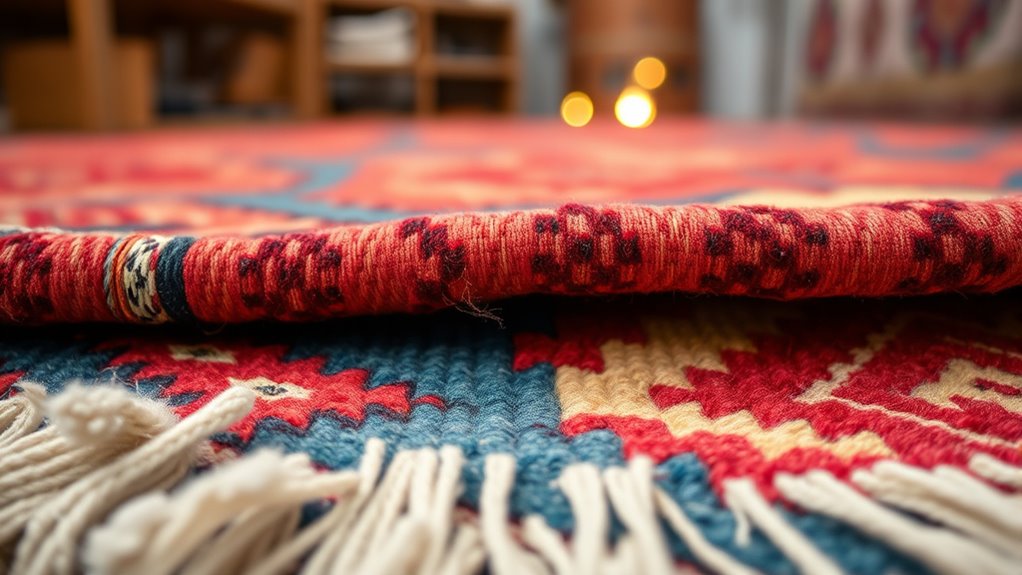Vintage rugs like Kilim and Beni Ourain add timeless charm to your space, but they need proper care to stay beautiful. Regular vacuuming with gentle settings, blotting spills immediately, and avoiding direct sunlight help preserve their fibers and dyes. Placing rugs in low-traffic areas and using rug pads can extend their lifespan. To keep them vibrant and intact, be mindful of moisture and light exposure. Keep exploring to learn more tips for maintaining these treasured textiles.
Key Takeaways
- Vintage rugs like Kilim and Beni Ourain add character but require gentle cleaning and proper placement to preserve their fibers and dyes.
- Regular vacuuming with gentle settings helps maintain vintage rugs without damaging delicate fibers.
- Avoid direct sunlight and damp areas to prevent fading and mold, and use rug pads for safety and longevity.
- Spot clean spills immediately with mild solutions, and rotate rugs periodically to promote even wear.
- Professional cleaning and careful handling extend the lifespan of vintage rugs, ensuring they retain their beauty over time.

Vintage rugs bring timeless charm and character to any space. They serve as focal points, adding warmth and personality that contemporary pieces often can’t match. But to preserve their beauty, you need to understand proper care, especially when it comes to rug cleaning techniques and rug placement tips. With the right approach, you’ll guarantee your vintage rug remains vibrant and intact for years to come.
Start by knowing the best rug cleaning techniques for vintage pieces. Unlike modern rugs, vintage textiles often require gentle handling. Regular vacuuming is essential, but avoid using beater bars or high suction that could damage delicate fibers. Instead, opt for a handheld attachment or a brushless vacuum setting to remove surface dirt without harming the weave. When spills occur, act quickly—blot the area with a clean, damp cloth rather than rubbing, which can embed stains further or fray the fibers. For deeper cleaning, consider professional rug cleaning services that specialize in vintage or antique rugs, as they understand the delicate dyes and materials involved. Spot cleaning with mild, pH-balanced solutions is also effective, but always test a small, inconspicuous area first to prevent color bleeding or fabric damage. Additionally, using proper cleaning methods helps maintain the rug’s integrity over time.
Rug placement tips are equally vital for maintaining your vintage rug’s integrity. You want to avoid placing it in direct sunlight, as prolonged exposure can fade colors and weaken fibers. Instead, position your rug in areas with filtered or indirect light. Also, consider the traffic level—vintage rugs are often more fragile than modern ones, so place them in low-traffic zones or areas where they won’t be constantly stepped on. Using rug pads not only prevents slipping but also provides cushioning, reducing wear and tear over time. When arranging your vintage rug, think about the overall room layout—center it beneath furniture to enhance symmetry or use it to define a specific zone, like a seating area. Be mindful of moisture and humidity levels; excessive dampness can cause mold or warp the fibers, so avoid placing vintage rugs in damp basements or near heaters. Furthermore, rotate your rug periodically to distribute wear evenly and preserve its appearance.
Frequently Asked Questions
How Do I Determine the Genuine Age of a Vintage Rug?
To determine the genuine age of a vintage rug, focus on age verification and authenticity markers. Examine the wear patterns—authentic vintage rugs show natural fading and signs of use. Look at the dye colors and weaving techniques, which often change over time. Check for repairs or new fibers that may indicate recent restoration. Consulting an expert or appraiser can also help verify its true age and guarantee you’re getting an authentic vintage piece.
What Are the Best Cleaning Methods for Delicate Vintage Rugs?
To clean delicate vintage rugs, start with gentle vacuuming to remove dirt. Use a mild detergent specifically formulated for wool or delicate fibers; avoid harsh chemicals. When stain removal, act quickly with a soft cloth dampened in cold water and a gentle stain removal tip—blot, don’t rub. Always test your detergent on a small hidden area first, ensuring it won’t damage or discolor the rug.
How Can I Identify the Region or Tribe a Vintage Rug Originates From?
A picture is worth a thousand words, so start by examining the rug’s tribal motifs and weaving techniques. You can identify its origin by analyzing the patterns, colors, and craftsmanship, as different regions have distinctive styles. Look for specific symbols or geometric designs unique to tribes like the Berbers or Persians. Researching these elements helps you connect the rug’s story to its cultural roots, revealing its true heritage.
What Should I Consider When Buying Vintage Rugs Online?
When buying vintage rugs online, you should verify authenticity to confirm you’re getting a genuine piece. Look for detailed photos, clear descriptions, and seller credentials. Don’t forget to compare prices across multiple sites to gauge fair market value. Ask for provenance or certification if available. Taking these steps helps you avoid fakes and overpaying, ensuring your purchase is both authentic and a good investment.
Are Vintage Rugs Suitable for High-Traffic Areas?
Like a trusty steed, vintage rugs can handle high-traffic areas if you choose wisely. Look for rugs with strong rug durability and traffic resistance, such as tightly woven kilims or Beni Ourain styles. These rugs withstand daily wear and tear, maintaining their beauty over time. Regular care and prompt stain removal will keep them looking their best, making them perfect for your lively, busy spaces.
Conclusion
As you explore vintage rugs like Kilim and Beni Ourain, remember they’re more than just beautiful textiles—they’re woven stories. Some say these rugs carry the spirits of their creators, making each piece a timeless connection to history. While this might be poetic, it reminds you to appreciate craftsmanship and tradition. Ultimately, choosing a vintage rug isn’t just about style; it’s about embracing a piece of cultural legacy that continues to tell its story through you.









